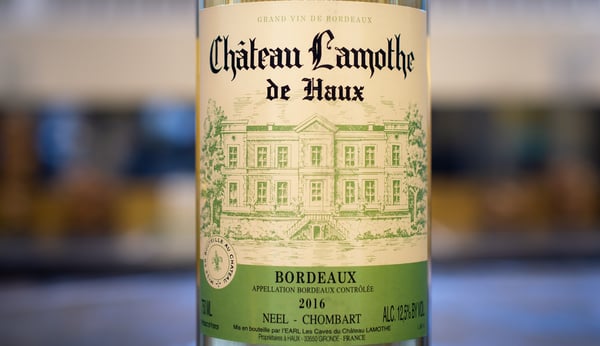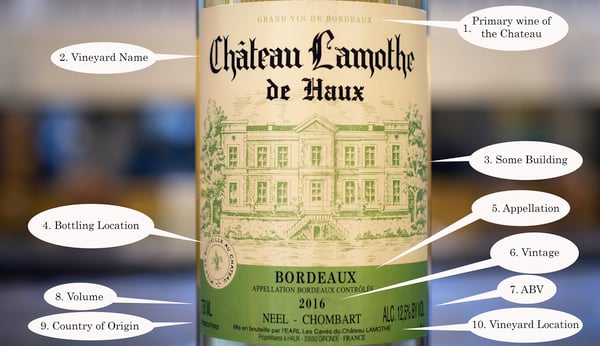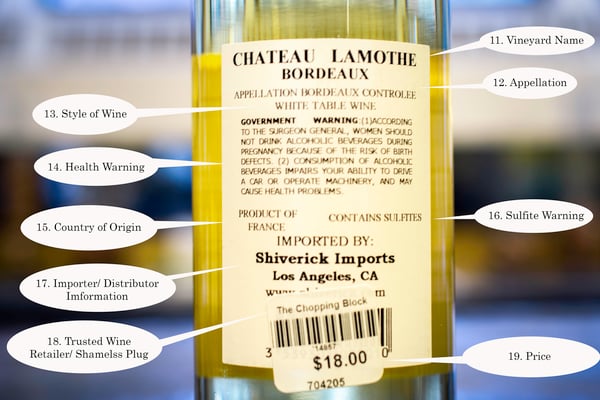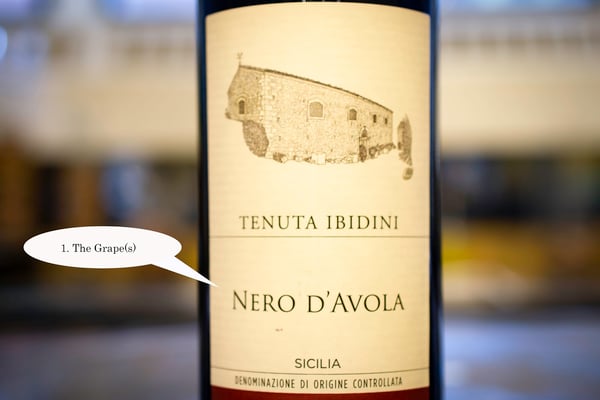
A customer walks into the store looking for a bottle of wine, they go to the wine wall, look up, and freeze like a deer in the headlights of an oncoming vehicle. I see this every day and we only carry about thirty-five labels. Wine can be really intimidating, especially if you're new to it, but I have found a nearly foolproof method for buying a good bottle of wine every time I go to the store and it only requires two things:
1) Knowing how to read a wine label
2) Knowing what you like

Assuming you'll have to buy a few bottles of wine to try before you can know what you like, knowing how to read a label is the most important step in this process. To make this easy, I made a diagram using one of our more popular white wines.

This is a pretty straight-forward example of a wine label. Some of the things you'll see here are standard for every bottle of wine, while others may relate only to it's country of origin or even just the wine region where it was produced.
- Grand vin de Bordeaux – “Grand wine of Bordeaux,” in the case of Bordeaux this means the wine is the vineyard's primary label, the main wine it produces. If the label read, “Grand vin de Bourgogne,” or “Grand vin de Champagne,” it would mean something totally different. Personally, I tend to ignore titles like this. While I think it's great the producers believe this is a great wine, it provides me with no guarantee I will enjoy the wine or that it will be any better than the bottle sitting next to it.
- Vineyard Name – This is the name of the vineyard that produced the wine. You can be reasonably certain that whenever you see “Chateau Whatever” on a label, that it's referring to the producer.
- Some Building – There's no guarantee that the building on any of these labels is where the wine is produced or if it even exists in reality. In the case of Chateau Lamothe, it does exist and there are some lovely photos of it on their website.
- Bottling Location – This is a consumer protection that indicates the wine in the bottle was actually produced where it was grown. It's common for grapes to be purchased and imported to produce wine. However, those wines that bear some standard such as “estate bottled,” “mise en bouteille au chateau,” or “mise en bouteille au domaine,” are telling consumers they did not source the grapes from outside.
- Appellation – This is the specific wine region in which the wine was produced. Each has their own rules regarding what grapes can be used, vine yields, how the grapes are to be harvested, how the wine is to be aged, and even how the labels are represented. This is a deep rabbit hole for someone new to wine, so for the beginner I would recommend simply noting this as indication of where the wine was made. In this case, it the wine is not simply French, it's Bordeaux.
- Vintage – The year in which the wine was produced. In the northern hemisphere this is also the year in which the vine growth occurred (except in rare cases, such as with Eiswein that may be harvested in January).
- ABV – “Alcohol by Volume.” Beyond telling us how much alcohol is in the wine, this may provide clues to the climate where the grapes were grown or how the wine was produced. Yeast generally dies around 15-16% alcohol, so anything higher has likely been fortified in some way. By comparison, wines with lower alcohol percentages (under 11.5%) will likely have more residual sugar and therefore be sweeter. Most wines fall within the range of 11.5- 14.5%. Because we know that yeast will consume sugar to produce alcohol, we can speculate that a wine with higher alcohol content came from a warmer region where it was allowed to more fully ripen, whereas wines with alcohol percentages between 11.5-12.5% likely came from cooler regions, where the grapes were not allowed to fully ripen.
- Volume – How much wine is in the bottle.
- Country of Origin – The country where the wine originated.
- Vineyard Location – Want to go check out that cool building on the label? Here's the address.
You thought we were done? That's cute. We're not done, there's a whole back label to look at. Okay fine, I'll skip the duplicated information.

11. Duplicated information
12. Duplicated information
13. Style of Wine – This is another deep rabbit hole. As if wine wasn't complicated enough, when you add bureaucracy it can become maddening. The notation of wine style on a label is for the purposes of taxation more than consumer awareness. In fact, the government classifications seem to contradict reality at times, when a 14.5% alcohol wine can be labeled as “dessert wine,” based on it's alcohol percentage rather than it's sugar content. Do yourself a favor, just ignore this and move on.
14. Health Warning – Government mandated warnings regarding the potentially hazardous impact of consuming alcohol. While I may encourage you to ignore taxation classifications, this is information you need to be aware of.
15. Duplicated information
16. Sulfite Warning – Sulfites are a natural byproduct of the fermentation process. If you want to learn more, check out my blog on this subject.
17. Importer/ Distributor Information – It's important for consumers to know where a wine comes from and knowing who brought it from the vineyard to the store is an important step in that process. Labels always name a wine's importer or distributor, their websites are generally good resources if you're looking for more information about a particular wine.
18. Trusted Wine Retailer – Hey, we don't just post blogs about wine, we sell it too!
19. Price – Probably the most important factor when buying a wine, never be afraid to ask for a price and don't assume that more expensive means better.
Okay, that about covers it... what? Oh, yeah, there's no mention of grapes anywhere on this label is there? Well, that's not as uncommon as you might think.
New World (America, Australia, Argentina, New Zealand, etc.) wines are marketed based on the names of grapes they're made from, but this attitude is reversed for a lot of Old World (France, Italy, Germany, etc.) wine, where the place it was made is more important than what it's made from. Sometimes there's no way to know exactly what grapes went into a wine, as some producers are very secretive about their process. Learning about the wine region can give you clues, so a quick Google search may tell you what you want to know. Other times you may just have to resign yourself to not knowing.
Then again, the grape name might be right in front of your face. Looking at this label, if you're unfamiliar with Nero d'Avola how would you know this was the grape the wine was made from?

There are over ten thousand grape varieties and it's common across the world to use local grapes. In my home state of Missouri, fine wine is being made from Chambourcin and Norton. In Romania you may be faced with the choice between Fetească Albă, Fetească Neagră, and Fetească Regală, which one would you choose? If you're unfamiliar with Greek wine you might not realize that all Nemean reds are made from Aghiorghitiko.
My point is, don't get too hung up on buying one particular grape; it's important to note what grape(s) a wine is made from, but don't let that be your deciding factor. Cabernet Sauvignon from Moldova tastes very different from Cabernet Sauvignon from Napa Valley.
If you want to learn more about wine, The Chopping Block has plenty of classes available on our calendar, as well as Happy Hour that happens twice a week: Tuesdays at 4:45pm at the Mart and Thursdays at 5:45pm at Lincoln Square.

